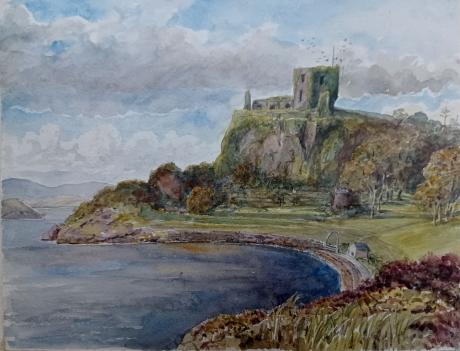inscribed and sigend with initials " Dunolly Castle / LWT"
Tom and Laura Taylor and thence by descent
From Wikipedia, the free encyclopedia

Dunollie Castle (Scottish Gaelic: Caisteal Dhùn Ollaigh) is a small ruined castle located on a hill north of the town of Oban, on the west coast of Scotland in Argyll. The site enjoys views over towards the island of Kerrera and a view of the town, harbour, and outlying isles. The castle is open to the public as part of the Dunollie Museum, Castle and Grounds.
There was a fortification on this high promontory in the Early Middle Ages, when Dunollie was the royal centre of the Cenél Loairn within the kingdom of Dál Riata. The Irish annals record that "Dun Ollaigh" was attacked or burned down three times, in 686, 698, and in 701. It was subsequently rebuilt in 714 by Selbach mac Ferchair (died 730), the King of Dál Riata credited with destroying the site in 701.Excavations in the 1970s suggest that this early fortification was abandoned some time in the 10th century.
The area around Dunollie subsequently became part of the semi-independent Kingdom of the Isles, ruled over by Somerled in the 12th century. On his death the MacDougalls became Lords of Lorne. Dougall, Somerled's son, held most of Argyll and also the islands of Mull, Lismore, Jura, Tiree, Coll and many others in the 12th century.
Excavations show that Dunollie was refortified with an earthwork castle in the 13th century or potentially the late 12th century. The builder may have been Dougall, or his son Duncan. Ewan MacDougall, great-grandson of Somerled and the third chief of the MacDougalls, switched the clan's allegiance in the mid 13th century: initially allied with Haakon IV of Norway, from the 1250s Ewan remained loyal to the kings of Scotland.
In the 14th century Ewan's grandson John MacDougall, along with his kinsmen the Comyns, sided with the Balliols against the interests of Robert the Bruce. John MacDougall's army defeated the Bruce at the Battle of Dalrigh in 1306, but Bruce returned in 1308 and crushed the MacDougalls at the Battle of the Pass of Brander. The MacDougall lands of Lorne were subsequently forfeit and were given to the Campbells, though Dunollie and other estates were regained later in the 14th century.

The existing castle ruins date largely from the 15th century.
The Marquis of Argyll captured the castle in 1644, but it was returned to the MacDougalls in 1661. In 1746, the MacDougalls abandoned Dunollie Castle and built Dunollie House just downhill from the castle ruins.
In recent years, a charitable trust was formed titled The MacDougall of Dunollie Preservation Trust, who are responsible for the care of the historic buildings and collections held in this an ancestral site. Today, the Dunollie Preservation Trust operates Dunollie Museum, Castle & Grounds - a visitor attractions and social enterprise. Through the running of this organisation, all funds raised contribute to ongoing conservation and development efforts as well as education and learning. Remains of a historical herb garden have recently been discovered in the castle grounds.
Laura Wilson Barker (6 March 1819 – 22 May 1905), was a composer, performer and artist, sometimes also referred to as Laura Barker, Laura W Taylor or "Mrs Tom Taylor".
She was born in Thirkleby, North Yorkshire, third daughter of a clergyman, the Rev. Thomas Barker. She studied privately with Cipriani Potter and became an accomplished pianist and violinist. As a young girl Barker performed with both Louis Spohr and Paganini. She began composing in the mid-1830s - her Seven Romances for voice and guitar were published in 1837. From around 1843 until 1855 she taught music at York School for the Blind. During this period some of her compositions - including a symphony in manuscript, on 19 April 1845 - were performed at York Choral Society concerts.
On 19 June 1855 she married the English dramatist, critic, biographer, public servant, and editor of Punch magazine Tom Taylor. Barker contributed music to at least one of her husband's plays, an overture and entr'acte to Joan of Arc (1871), and provided harmonisations as an appendix to his translation of Ballads and Songs of Brittany (1865).
Her other works include the cantata Enone (1850), the violin sonata A Country Walk (1860), theatre music for As You Like It, (April 1880), Songs of Youth (1884), string quartets, madrigals and solo songs. Her choral setting of Keats's A Prophecy, composed in 1850, was performed for the first time 49 years later at the Hovingham Festival in 1899. The composer was present.
Several of Barker's paintings hang at Smallhythe Place in Kent, Ellen Terry's house.
Barker lived with her husband and family at 84 Lavender Sweep, Battersea. There were two children: the artist John Wycliffe Taylor (1859–1925), and Laura Lucy Arnold Taylor (1863–1940). The Sunday musical soirees at the house attracted many well-known attendees, including Lewis Carroll, Charles Dickens, Henry Irving, Charles Reade, Alfred Tennyson, Ellen Terry and William Makepeace Thackeray.
Tom Taylor died suddenly at his home in 1880 at the age of 62. After his death, his widow retired to Porch House, Coleshill in Buckinghamshire, where she died on 22 May 1905, aged 86.

